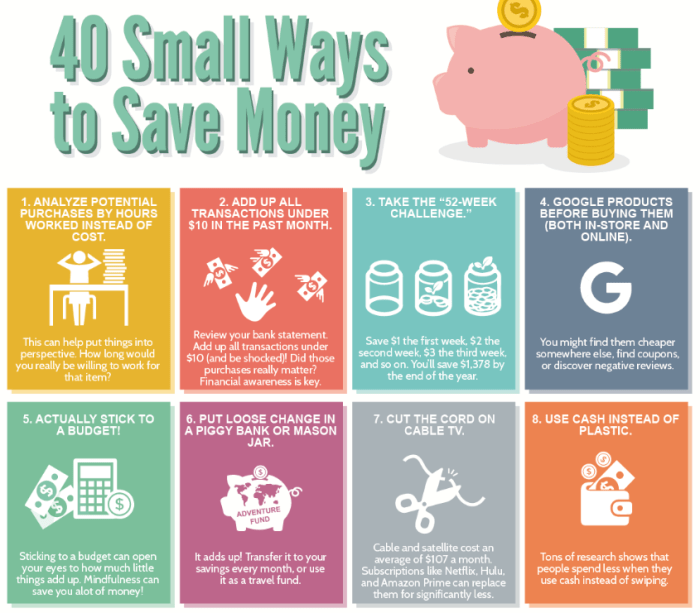How to same money – Embark on a journey towards financial empowerment with our comprehensive guide on how to save money. From budgeting basics to smart shopping strategies, we’ve got you covered. Dive in and unlock the secrets to financial success.
In today’s fast-paced world, managing finances can be a daunting task. But fear not! Our guide will simplify the complexities of money management, providing you with practical tips and actionable advice to help you save more, spend wisely, and secure your financial future.
Budgeting
Budgeting is the process of creating a plan for how you will spend your money. It involves tracking your income and expenses, and allocating your money to different categories, such as housing, food, transportation, and entertainment.
Budgeting is important because it helps you to:
- Track your spending and identify areas where you can cut back.
- Make informed decisions about how to spend your money.
- Avoid debt and save for the future.
Creating a Budget
To create a budget, you need to:
- Track your income and expenses for a month.
- Categorize your expenses.
- Set financial goals.
- Allocate your money to different categories.
- Review your budget regularly and make adjustments as needed.
Using Budgeting Apps or Software
There are many budgeting apps and software programs available that can help you to create and track your budget. These tools can make budgeting easier and more efficient.
Some popular budgeting apps include:
- Mint
- YNAB (You Need a Budget)
- EveryDollar
Some popular budgeting software programs include:
- Quicken
- Moneydance
- GnuCash
Saving Habits: How To Same Money

Cultivating sound saving habits is crucial for financial well-being. To effectively manage your finances, it’s essential to understand the various types of savings accounts, establish automated savings transfers, and implement strategies to minimize expenses and maximize savings.
Types of Savings Accounts
Different savings accounts offer varying features and benefits. Here are some common types:
- Regular Savings Account:A basic account with limited withdrawals, offering a low interest rate.
- High-Yield Savings Account:A savings account that typically earns a higher interest rate than regular accounts.
- Money Market Account (MMA):A hybrid account that combines checking and savings features, often offering higher interest rates than savings accounts but with fewer withdrawal limits.
- Certificate of Deposit (CD):A time-locked account where you deposit funds for a fixed term, earning a fixed interest rate.
Automatic Savings Transfers
Setting up automatic savings transfers is a convenient and effective way to ensure regular savings. You can schedule transfers from your checking account to your savings account on a specific date each month.
- Set a Realistic Amount:Determine an amount you can consistently transfer without straining your budget.
- Choose the Right Date:Pick a date that aligns with your income schedule, such as payday.
- Automate the Process:Contact your bank or set up online banking to automate the transfers.
Reducing Expenses and Increasing Savings
To maximize savings, it’s essential to reduce unnecessary expenses and find ways to increase your income. Here are some tips:
- Track Expenses:Use a budgeting app or spreadsheet to monitor your spending and identify areas where you can cut back.
- Negotiate Bills:Contact service providers (e.g., phone, internet, insurance) to negotiate lower rates or payment plans.
- Consider Side Hustles:Explore part-time work, freelance opportunities, or selling unwanted items to supplement your income.
Smart Shopping

Smart shopping involves making informed decisions to save money on everyday purchases. It includes finding the best deals on groceries, clothing, and other household items. By implementing smart shopping strategies, you can significantly reduce your expenses and free up more funds for other financial goals.
Groceries, How to same money
Groceries account for a substantial portion of household expenses. Here are some tips to save money on groceries:
- Plan your meals ahead of time to avoid impulse purchases.
- Use coupons, promo codes, and cashback apps to get discounts.
- Buy generic brands whenever possible.
- Compare prices at different grocery stores before making purchases.
- Take advantage of sales and discounts.
- Consider buying in bulk to save money in the long run.
Clothing
Clothing is another area where you can save money with smart shopping. Here are some tips:
- Shop during sales and clearance events.
- Look for coupons and promo codes before making purchases.
- Consider buying second-hand clothes.
- Invest in high-quality items that will last longer.
- Shop at discount stores or online retailers.
Other Household Items
In addition to groceries and clothing, there are many other household items you can save money on. Here are some tips:
- Compare prices online before making purchases.
- Use coupons and promo codes.
- Look for discounts and sales.
- Consider buying used items.
- Negotiate with vendors and service providers.
Negotiating
Negotiation is a valuable skill that can help you save money on various purchases. Here are some tips for effective negotiation:
- Do your research and know what you’re willing to pay.
- Be prepared to walk away from a deal if you’re not satisfied.
- Be polite and respectful, even if the negotiation gets tough.
- Don’t be afraid to ask for discounts or concessions.
By implementing these smart shopping strategies, you can significantly reduce your expenses and improve your financial well-being. Remember, saving money is not about depriving yourself but about making informed decisions and maximizing the value of your purchases.
Debt Management

Debt is a common part of life for many people. However, managing debt effectively is crucial for maintaining financial health. Different types of debt can have varying impacts on your finances, and it’s essential to understand the consequences of each.
Types of Debt
- Secured Debt:Secured debt is backed by collateral, such as a house or car. If you fail to repay the loan, the lender can seize the collateral.
- Unsecured Debt:Unsecured debt is not backed by collateral. This includes credit cards, personal loans, and medical bills. Lenders typically charge higher interest rates on unsecured debt due to the increased risk.
- Good Debt:Good debt is debt that helps you build wealth or improve your financial situation. Examples include student loans for education or mortgages for a home.
- Bad Debt:Bad debt is debt that does not provide any financial benefit and can damage your credit score. Examples include payday loans and high-interest credit card debt.
Debt Consolidation and Repayment Strategies
If you’re struggling with multiple debts, debt consolidation can be a helpful option. This involves combining your debts into a single loan with a lower interest rate, making it easier to manage your payments. There are different debt repayment strategies available, such as the snowball method or the avalanche method.
The snowball method involves paying off the smallest debt first, while the avalanche method focuses on paying off the debt with the highest interest rate first.
Avoiding High-Interest Debt and Improving Credit Scores
- Avoid Payday Loans:Payday loans are short-term, high-interest loans that can trap you in a cycle of debt.
- Limit Credit Card Spending:Use credit cards responsibly and avoid carrying a high balance. Pay off your credit card bills in full each month to avoid paying interest.
- Build a Good Credit Score:A good credit score is essential for securing favorable interest rates on loans. Pay your bills on time, keep your credit utilization low, and avoid applying for too much credit in a short period.
Investing for the Future
Investing is a crucial aspect of long-term wealth accumulation. It involves putting your money into various assets with the potential to grow over time. By investing wisely, you can potentially increase your savings and secure your financial future.
Different Investment Options
- Stocks:Represent ownership shares in companies. They offer the potential for high returns but also carry higher risk.
- Bonds:Loans made to governments or corporations. They generally offer lower returns than stocks but carry lower risk.
- Mutual Funds:Collections of stocks and bonds managed by professionals. They provide diversification and reduce risk.
Creating a Diversified Portfolio
To mitigate risk, it’s essential to create a diversified investment portfolio. This involves investing in a mix of different asset classes, such as stocks, bonds, and real estate. By diversifying, you reduce the impact of any single investment’s performance on your overall portfolio.
Remember: Investing involves risk, and past performance is not a guarantee of future results. It’s crucial to research and understand different investment options before making any decisions.
Saving money can be a daunting task, but it’s essential for financial security. If you’re looking for ways to save more, check out how to save all your money . This comprehensive guide provides actionable tips on budgeting, reducing expenses, and investing wisely.
Financial Planning
Financial planning is the process of creating a roadmap for your financial future. It helps you identify your financial goals, develop a strategy to achieve them, and make informed decisions about how to manage your money.A comprehensive financial plan should include several key components, such as:
Retirement Planning
Retirement planning is essential for ensuring you have enough money to live comfortably in your golden years. It involves estimating your retirement expenses, determining how much you need to save, and choosing the right investment vehicles.
Saving money can be a daunting task, but it’s crucial for financial security. Learn the art of saving all your money with this comprehensive guide: how to save all your money . Discover proven strategies for budgeting, cutting expenses, and maximizing your savings.
Start your journey to financial freedom today!
Insurance
Insurance is a crucial part of financial planning. It provides protection against unexpected events, such as accidents, illnesses, or property damage. There are many different types of insurance available, so it’s important to assess your needs and choose the right coverage for you.
Estate Planning
Estate planning is the process of planning for the distribution of your assets after you die. It involves creating a will, a trust, and other legal documents to ensure your wishes are carried out. Estate planning can also help minimize taxes and probate costs.
Closure
As you implement these strategies, you’ll not only save money but also gain invaluable financial literacy. Remember, the path to financial freedom is paved with knowledge and discipline. Embrace these principles, and you’ll be well on your way to achieving your financial goals.
FAQ
What’s the easiest way to start saving money?
Creating a budget is the foundation of effective saving. Track your income and expenses to identify areas where you can cut back.
How can I reduce unnecessary expenses?
Evaluate your spending habits and eliminate non-essential purchases. Consider negotiating bills, using coupons, and exploring cashback apps.
What’s the best way to handle debt?
Prioritize high-interest debt and consider debt consolidation or repayment plans. Seek professional advice if necessary.

